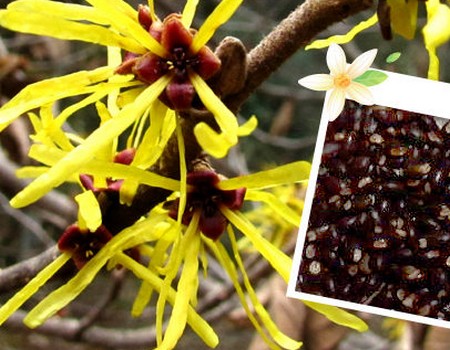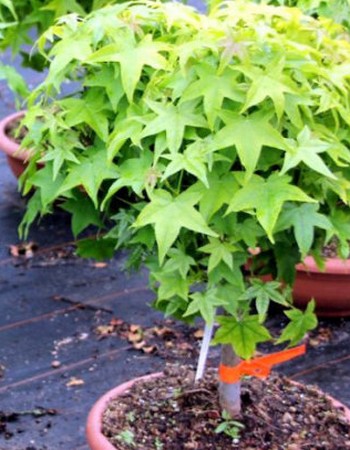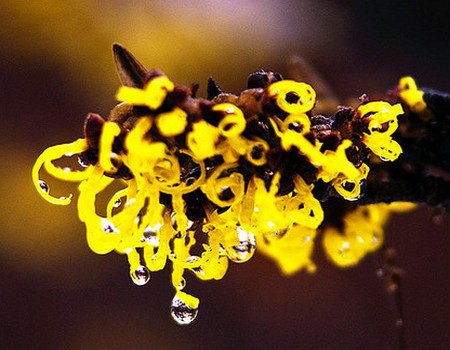Sowing and propagation techniques of witch hazel
The shape of the flower is strange and fragrant, the first leaves of the grass open in spring, and the yellow slender petals are like golden wisps, covered with branches, which are very lovable. Gardens at home and abroad are often cultivated, and some good varieties appear, which is one of the famous ornamental flowers and trees. It is suitable in the corner of the courtyard, by the pool, by the stream, among the rocks and on the outer edge of the trees. In addition, flower branches can be used as vase materials for cut flowers. If you want to promote flowering, cut off the branches and place them in a 20 ℃ greenhouse between December and January of the following year. It will blossom in about 10-20 days.

The fruit of witch hazel is a capsule, which is easy to crack after ripening, so it should be harvested in time and placed in a bamboo dustpan to prevent the seeds from escaping.
After the seeds are collected, they can also be sown immediately, or the seeds can be hidden in sand until the next spring when the flowers bloom.
For the sowing and propagation of witch hazel, the seedling bed should choose the site of sunny dry, deep soil and fertile slightly acidic soil, apply some accumulated dry and miscellaneous fertilizer, or stable manure, and then turn it deeply and rake flat to make an open field seedbed.
The size of the seedbed should be based on the number of seeds and the convenience of production. It is generally 300cm long, 80cm 120cm wide and 30cm 35cm high.
When the seedbed is ready, sift the seeds out of the river sand, sow them in the seedbed, cover the fine sand, and sprinkle the water thoroughly with a sprinkler. The seedbed should also be covered with straw, pay attention to keep the soil moist, and remove the covered straw in time after the seedlings are unearthed.
When seedlings grow out of 4-6 true leaves, weeds should be removed in time, fertilizer and water management should be strengthened, and a shed should be built for shade in summer to prevent hot sun exposure.
In autumn, seedlings can be carried out at one time according to the thinning density of seedlings in the seedling bed, and the main roots can be truncated at the same time to promote the growth of lateral roots and fibrous roots.
Generally, after 1-2 years of careful cultivation, the spring shoots were planted and cultivated before the spring shoots germinated in the third year.
Golden plum blossoms from December to March of the following year. The ripening period is October. The capsule is yellowish brown when mature and has the habit of dehiscing the seedling seeds. Therefore, the harvested fruit should be covered and dried to avoid the loss of seedling seeds. A thousand seeds of seedlings weigh 65 grams.
Seedling seeds have a long dormant period, so they do not germinate in the same year after sowing, but will germinate in the spring of the following year. Therefore, most of the seedling seeds use wet sand stratification for one year, and then sow in autumn or spring. Strip sowing is used with row spacing of 20-25 cm and sowing depth of 2 cm. Cover the soil after sowing, shade the sun after emergence, keep the soil moist, pay attention to waterlogging in the rainy season, and stop shading in mid-late September. The seedlings will continue to be cultivated in place for a year. After the end of the second year, they were retransplanted to cultivate big seedlings.
Time: 2019-06-11 Click:
- Prev

Propagation methods of witch hazel
Golden plum blossom is peculiar in shape and fragrant, early spring leaves bloom, petals such as line, light and graceful, for the important early spring flowering seedlings. It is suitable for solitary planting in the corners of dry gardens, the banks of poolside streams and the edges of seedling bushes. it is also a good material for making bonsai. Witch hazel's peculiar petals and graceful tree posture attract many people.
- Next

Propagation Technique of Hamamelis chinensis by Layering
Witch hazel is mostly born on hillsides, valleys and other places. It is an alpine tree species and a warm-ground tree species. However, witch hazel has strong cold resistance and can grow in the open at minus 15℃. Witch hazel is mainly propagated by sowing, but also by layering and grafting
Related
- Fuxing push coffee new agricultural production and marketing class: lack of small-scale processing plants
- Jujube rice field leisure farm deep ploughing Yilan for five years to create a space for organic food and play
- Nongyu Farm-A trial of organic papaya for brave women with advanced technology
- Four points for attention in the prevention and control of diseases and insect pests of edible fungi
- How to add nutrient solution to Edible Fungi
- Is there any good way to control edible fungus mites?
- Open Inoculation Technology of Edible Fungi
- Is there any clever way to use fertilizer for edible fungus in winter?
- What agents are used to kill the pathogens of edible fungi in the mushroom shed?
- Rapid drying of Edible Fungi

